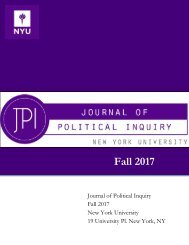JPI Spring 2018
You also want an ePaper? Increase the reach of your titles
YUMPU automatically turns print PDFs into web optimized ePapers that Google loves.
Defining the Undefinable:<br />
In Search for a Definition of Terrorism<br />
Jaella Brockmann<br />
Over the years, scholars, journalists, and policy makers have struggled to establish a<br />
comprehensive definition of the various forms terrorism found in the modern world. While definitions<br />
are often contested by many, the case for a definition of terrorism poses particular problems due to<br />
its need for an all-encompassing applicability to real-world cases. Jack Gibbs’s use of the term<br />
“atheoretical criterion” poses various problems that will be further delineated herein 1 . For the purpose<br />
of this essay, the criterion for a definition of terrorism that will be examined is : “the use of seemingly<br />
random violence by a sub-state actor against non-combatants for political ends” 2 . After an<br />
examination of these exceptions, which will be clarified in the following, I will argue that a universal<br />
definition of terrorism is impossible to establish. I believe that such an impossibility is inherent when<br />
defining terrorism as the context of each case of terrorism is far too unique to allow for a general<br />
universal meaning.<br />
CHARACTERISTICS OF AN ESTABLISHED DEFINITION<br />
In the following section, I will briefly examine the validity of each criterion with respect to<br />
real-world applicability as well as its functionality as a general criterion.<br />
“Seemingly random violence”<br />
This aspect of a possible definition might, due to its relativity, be the easiest to apply to any<br />
case of terrorism as it is broad enough to apply to all agents and agendas. Still, it is questionable in<br />
how far “seemingly” random violence can be identified. Thus, while the inclusion of the possibility of<br />
subjective assessments regarding one’s own judgement is crucial, it also poses various difficulties.<br />
First, the criterion poses a question of agency. Must violence seem random for this criterion<br />
to apply? It can here be assumed that agents of the state would be responsible for this matter, deciding<br />
whether or not to react with counterterrorism-measures—such measures could potentially lead to<br />
questioning of the state agents’ intentions. Additionally, this leads to an important question: what<br />
exactly is seemingly random violence? Does this also apply to cases in which an inexperienced observer<br />
might condemn a form of violence as random while others with more insight might recognize an<br />
underlying pattern of violence?<br />
Consider the case of the Popular Front for the Liberation of Palestine (PFLP), which<br />
performed various airplane hijackings in the 1960s and 1970s. While the specific machines might have<br />
been randomly chosen, they also served to fulfill a certain purpose - the attraction of international<br />
recognition. Can acts performed in order to “produce the largest number of casualties possible” 3 still<br />
be considered random, or rather intentional actions executed to achieve a specific outcome?<br />
The inquiry becomes even more complex if we consider previous attacks by Muslim citizens<br />
on the Al-Aqsa Mosque in Israel. It is important to note that this mosque is considered “Islam’s third<br />
1<br />
Gibbs, J. P. (1989). Conceptualization of Terrorism. American Sociological Review, p. 330<br />
2<br />
Gottlieb, S. (2017). Midterm. NYU Seminar Terrorism & Counterterrorism.<br />
3<br />
Post, J. (2010). Terrorism and Political Violence. Routledge.<br />
<strong>JPI</strong> Fall 2017, pg. 4
















